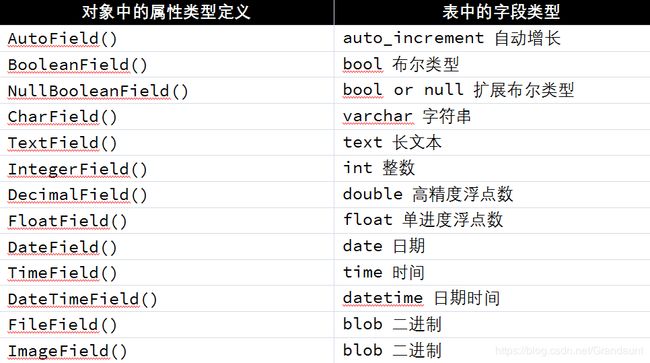Python_mysql增删改查
Django ORM操作数据库常用API
官方文档
https://docs.djangoproject.com/en/1.11/topics/db/queries/

1.models中构造数据表
 每个字段定义时,都会有自己的一些特殊的选项指定
每个字段定义时,都会有自己的一些特殊的选项指定
 在大部分项目中,还会涉及到多表关联操作
在大部分项目中,还会涉及到多表关联操作

class Play(models.Model):
date = models.CharField(max_length=255)
ischeck = models.TextField()
content = models.TextField()
userno = models.TextField()
def __str__(self): # __unicode__ on Python 2
return self.name
class Blog(models.Model):
name = models.CharField(max_length=100)
tagline = models.TextField()
def __str__(self): # __unicode__ on Python 2
return self.name
class Author(models.Model):
name = models.CharField(max_length=200)
email = models.EmailField()
def __str__(self): # __unicode__ on Python 2
return self.name
class Entry(models.Model):
blog = models.ForeignKey(Blog, on_delete=models.CASCADE)
headline = models.CharField(max_length=255)
body_text = models.TextField()
pub_date = models.DateField()
mod_date = models.DateField()
authors = models.ManyToManyField(Author)
n_comments = models.IntegerField()
n_pingbacks = models.IntegerField()
rating = models.IntegerField()
def __str__(self): # __unicode__ on Python 2
return self.headline
2.执行命令就可生成数据库表
python manage.py makemigrations
python manage.py migrate
3.view中调用
def testModel(request):
b = Blog(name='Beatles Blog',tagline='All the lastest Beatles news')
b.save()
return HttpResponse("hello world")
4.改变对象的值
b5.name = 'New name'
b5.save()
5.保存 ForeignKey 和 ManyToManyField 字段
现在,我们数据已经保存了,并已经建立了关联
在model中,Entry关联了外键Blog(ForeignKey )
所以在创建Entry的时候,要先获取一个Blog对象,给Entry赋值之后,才执行保存数据库的操作
from blog.models import Blog, Entry
entry = Entry.objects.get(pk=1)
cheese_blog = Blog.objects.get(name="Cheddar Talk")
entry.blog = cheese_blog
entry.save()
6.更新ManyToManyField的工作方式略有不同,在字段上使用add()方法将记录添加到关系中。这个示例将Author实例joe添加到条目对象
from blog.models import Author
joe = Author.objects.create(name="Joe")
entry.authors.add(joe)
7.要一次性向ManyToManyField添加多条记录,请在add()调用中包含多个参数,如下所示
john = Author.objects.create(name="John")
paul = Author.objects.create(name="Paul")
george = Author.objects.create(name="George")
ringo = Author.objects.create(name="Ringo")
entry.authors.add(john, paul, george, ringo)
8.取回数据
要从数据库检索对象,请通过模型类上的管理器构造一个QuerySet。QuerySet表示数据库中的对象集合。它可以有0个,1个或多个过滤器。过滤器根据给定的参数缩小查询结果。在SQL术语中,QuerySet等同于SELECT语句,过滤器是一个限制子句,例如WHERE或LIMIT。通过使用model s管理器可以获得一个查询集。每个模型至少有一个管理器,在默认情况下称为对象。直接通过model类访问它,如下所示
Blog.objects
b = Blog(name='Foo', tagline='Bar')
b.objects
Traceback:
...
AttributeError: "Manager isn't accessible via Blog instances."
# data = entry.authors.iterator()
注意:只有通过模型类才能访问管理器,而不是从模型实例访问管理器,以强制表级操作和记录级操作之间的分离。
9.查询所有数据
all_entries = Entry.objects.all()
10.按条件查询
filter(**kwargs) 返回一个新的匹配查询参数后的QuerySet
exclude(**kwargs) 返回一个新的不匹配查询参数后的QuerySet
Entry.objects.filter(pub_date__year=2006)
q2 = q1.exclude(pub_date__gte=datetime.date.today())
11.链接查询
Entry.objects.filter(headline__startswith='What')
.exclude(pub_date__gte=datetime.now())
.filter(pub_date__gte=datetime(2005, 1, 1))
12.延迟查询
创建QuerySets不会触及到数据库操作,你可以多个过滤合并到一起,直到求值的时候django才会开始查询
q = Entry.objects.filter(headline__startswith="What")
q = q.filter(pub_date__lte=datetime.now())
q = q.exclude(body_text__icontains="food")
13.检索单个对象
one_entry = Entry.objects.get(pk=1)
14.限制查询:分页/排序查询
Entry.objects.all()[:5]
Entry.objects.order_by('headline')[0:1].get()
15.字段查询
Entry.objects.filter(pub_date__lte='2006-01-01')
转换成SQL:
SELECT * FROM blog_entry WHERE pub_date <= '2006-01-01';
16.exact
Entry.objects.get(headline__exact="Man bites dog")
转换成SQL:
SELECT ... WHERE headline = 'Man bites dog';
17.iexact——忽略大小写
Blog.objects.get(name__iexact="beatles blog")
18.contains——包含查询,区分大小写
Entry.objects.get(headline__contains='Lennon')
转换成SQL:
SELECT ... WHERE headline LIKE '%Lennon%';
icontains 不区分大小写
startswith,endswith,istartswith,iendswith
19.连接查询
查询blog__name匹配的,返回Entry
Entry.objects.filter(blog__name__exact='Beatles Blog')
查询entry__headline匹配的,返回Blog
Blog.objects.filter(entry__headline__contains='Lennon')
如果跨越多层关系查询,中间模型没有值,django会作为空对待不会发生异常
Blog.objects.filter(entry__author__name='Lennon');
Blog.objects.filter(entry__author__name__isnull=True);
Blog.objects.filter(
entry__author__isnull=False,
entry__author__name__isnull=True);
20.F对象,对字段进行操作。就像SQL中,A列+B列。F对象很少用
from django.db.models import F
Entry.objects.filter(n_pingbacks__lt=F('n_comments'))
列加减乘除都可以
Entry.objects.filter(n_pingbacks__lt=F('n_comments') * 2)
Entry.objects.filter(rating__lt=F('n_comments') + F('n_pingbacks'))
Entry.objects.filter(author__name=F('blog__name'))
16.like语句转义百分号
Entry.objects.filter(headline__contains='%')
转义为:
SELECT ... WHERE headline LIKE '%\%%';
21.删除
q = Entry.objects.filter(headline__startswith="What")
q.delete()
22.批量修改
Entry.objects.filter(pub_date__year=2007).update(headline='Everything is the same')
一次性修改所有的Entry的blog属性指向
b = Blog.objects.get(pk=1)
Entry.objects.all().update(blog=b)
update也可以使用F()
Entry.objects.update(headline=F('blog__name'))
23.One-to-many关系
e = Entry.objects.get(id=2)
print e.blog # Hits the database to retrieve the associated Blog
e = Entry.objects.select_related().get(id=2)
print e.blog # 不会在向数据库取; 使用缓存中的值.
b = Blog.objects.get(id=1)
b.entry_set.all() # 返回所有blog的关联对象.
b.entry_set is a Manager that returns QuerySets.
b.entry_set.filter(headline__contains='Lennon')
b.entry_set.count()
b = Blog.objects.get(id=1)
b.entries.all() # 返回所有blog的关联对象
b.entries is a Manager that returns QuerySets.
b.entries.filter(headline__contains='Lennon')
b.entries.count()
add(obj1, obj2, ...) 把多个对象建立连接
create(**kwargs) 建立新对象
remove(obj1, obj2, ...) 移除多个关系对象
clear() 清理所有关系对象
24.Many-to-many关系
e = Entry.objects.get(id=3)
e.authors.all() # 返回Entry所有authors
e.authors.count()
e.authors.filter(name__contains='John')
a = Author.objects.get(id=5)
a.entry_set.all() # 返回Author所有entry
25.One-to-one关系
要在定义模型的时候设置
class EntryDetail(models.Model):
entry = models.OneToOneField(Entry)
details = models.TextField()
ed = EntryDetail.objects.get(id=2)
ed.entry # 返回 Entry 对象.